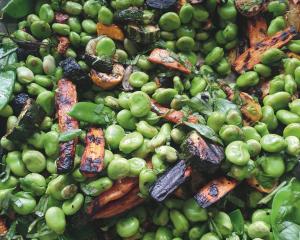
A lot has changed in your life since your last major Nude Food cookbook. You’re a mum of three, live and work on a farm. How has all of that influenced your cooking and relationship to food?
It’s made my cooking simpler and more grounded. Meals need to be nourishing and quick, but still feel a bit special. Going into farming has deepened my understanding and respect for how we produce food and get it to our plates — we eat what’s abundant, waste less, and cook in tune with the seasons.
What have you learned over that time that has surprised you?
Being in the farming and food production game gives you a real appreciation for how little control we have over nature, and therefore how well (or not) we will do from each season, which is humbling.
What has been the most bizarre moment you've experienced?
Standing in a field of millions of sunflowers during the "golden hour" (when the sun is setting) is surreal.
What is your favourite time of year food wise?
I love all the seasons, but in late summer/early autumn, the garden and fruit trees are overflowing. There is such an abundance of fresh produce to cook with and eat! Couldn't choose a favourite dish to cook — there's too many!
What dish is frequently on the menu for the boys for dinner at the moment?
I've just taught the boys how to make smashed beef burgers (from the cookbook) and gnocchi (also from the cookbook) themselves. So the plan is they're on dinner duty at least once a week.
How do you juggle the boys’ different tastes and food preferences?
Ninety percent of the time they have the same meal Carlos and I are having. The rule is they don't have to eat something if they reeeeally don't like it, but they do have to at least try it. And if they're not going to eat their veges at dinner time, then they need to have some veggie sticks and/or fruit after dinner. It seems to be working — both my older boys, who are 6 and 9 years old now, will try everything and are pretty good eaters, but they weren't always. Arlo (who is 2 years old), on the other hand, can be picky — he loves meat and fruit, but not that much else. I end up feeding him his leftover dinner when he's in the bath!
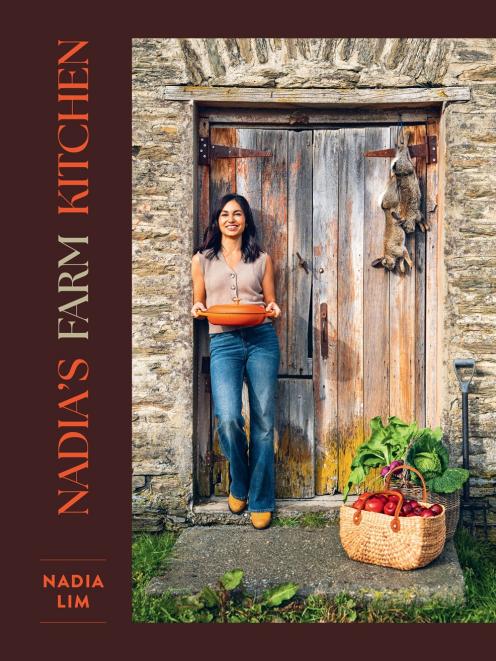
Tell us about the new book.
I'm so excited about Nadia's Farm Kitchen launching — it's my best book yet! It’s a collection of over 90 recipes we cook for family and friends on the farm using the produce we raise and grow, as well as from our local region, woven with stories of farm life. Divided into seasons, it shows the connection between what’s on the plate and where it comes from. The photography in the book, which has been captured through the seasons over the last five years on the farm, is stunning.
What are your can't-do-without ingredients to grow and then cook with?
Lemons, extra-virgin olive oil and fresh herbs.
Given your busy life, do you have any tips for time-poor parents wanting to put good food on the table?
Keep it simple. Batch cook so you've got at least part of a meal to pull out of the fridge/freezer on those extra busy nights ... and don't forget, beans on toast with a poached egg counts as dinner too!
Any tips for budding gardeners out there looking to plant a few things this year?
Grow what you’ll actually eat lots of — salad greens, tomatoes, herbs — they're all things that are quick and easy to grow, with a fast turnover ... and invest in good compost. Get into the habit of picking/harvesting at the right time before things go past their best — it's not like you can choose when you want something at a supermarket.
If you were having a few friends and their families around for a casual spring/summer gathering — what would you have on the menu and why?
A menu straight out of my new book — grilled peaches with marinated tomatoes and burrata, herbed lamb on the barbecue, grilled greens with greek yoghurt and lemon burnt butter, a fresh salad, new potatoes or the sunflower oil foccacia from the book. And either roasted stonefruit ice-cream for dessert, or sunflower oil chocolate mousse. It's a great menu for entertaining because you can pre-make dessert, pre-marinate the lamb, and the starter is a really quick and simple one to make.
The book
Images and text extracted from Nadia’s Farm Kitchen by Nadia Lim, published by Nude Food Inc, RRP $55.
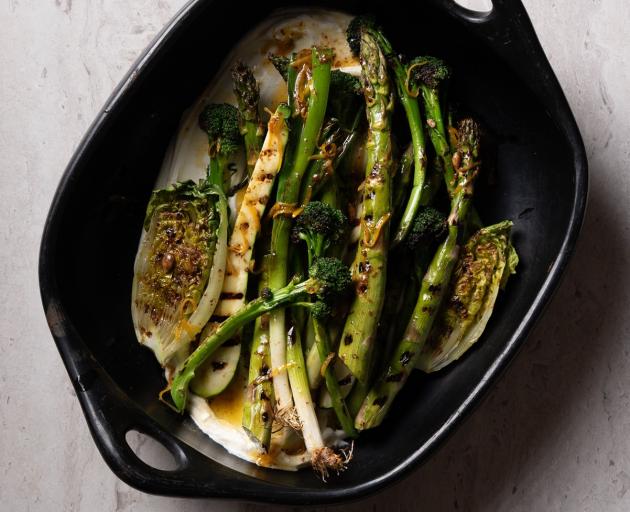 Grilled greens with Greek yoghurt and burnt lemon butter
Grilled greens with Greek yoghurt and burnt lemon butter

Charred greens, creamy yoghurt and buttery lemon sauce — what’s not to love? The veggies get smoky and sweet on the grill, the yoghurt adds a lovely tang and the burnt lemon butter is totally addictive. This is the kind of dish that makes you want to eat all your greens and then some. It’s perfect for making the most of spring and summer vegetables, when everything’s fresh, green and just begging to be grilled. You could also grill green beans, kale and even thin wedges of cabbage — yum!
Serves 4-6
Prep time 10min
Cook time 10-15min
Ingredients
350g broccolini
1-2 cos lettuce hearts, cut in half lengthways
3-4 courgettes, quartered lengthways
1 bunch spring onions, trimmed
1-2 bunches asparagus spears, ends trimmed
50g butter
Zest and juice of 1 lemon
200g natural, unsweetened greek yoghurt
Method
Toss vegetables with a drizzle of oil and a pinch of salt. Preheat a barbecue grill or grill pan until hot. Grill vegetables until lightly charred and just tender. Set aside.
In a small saucepan, melt the butter over medium heat. Let it continue to cook, swirling occasionally, until the foam subsides and the milk solids turn a deep golden brown. You’ll notice a nutty, toasty aroma, and this is your cue that the butter is ready. Watch it closely, as it can quickly go from golden to burnt. As soon as the butter is golden and fragrant, remove it from the heat and immediately stir in the lemon zest and juice. The mixture will bubble and sizzle.
Spread the yoghurt on to a serving platter and arrange the grilled vegetables on top of the yoghurt and spoon the burnt lemon butter over everything. Serve immediately.
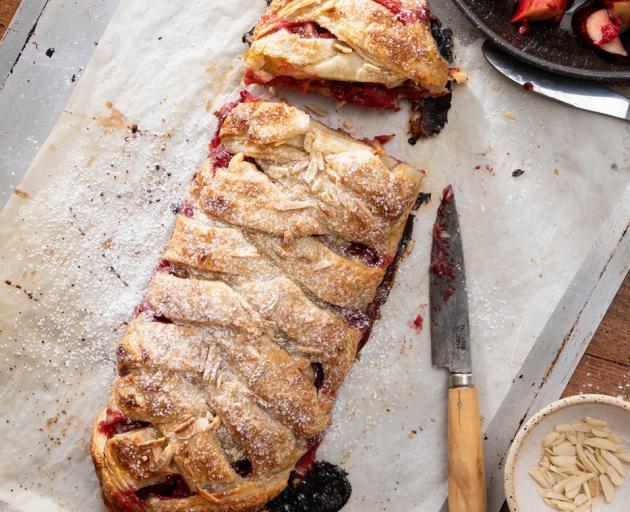
Rhubarb, raspberry and ginger strudel braid
A beautifully braided pastry, bursting with tart rhubarb, juicy raspberries and warming ginger, all wrapped in golden puff pastry with a sweet almond crunch. It’s an eye-catching dessert or morning tea treat that’s easier to make than it looks. Serve it slightly warm with a scoop of ice cream, a dollop of creme fraiche, or thick yoghurt for a real treat.
Serves 6-8
Prep time 20min
Cook time 35min
Ingredients
400g rhubarb, trimmed and cut into 2.5cm pieces
150g fresh raspberries (or frozen)
4-5 Tbsp sugar, to taste
zest of ½ lemon
1 tsp finely grated fresh ginger
1 tsp cornflour (to soak up juices)
½ tsp ground cinnamon
1 large sheet puff pastry (about 25-30cm wide × 35-40cm long), kept cold (note: if you use the Paneton brand, it conveniently comes in this size)
1 free-range egg
1 Tbsp milk, for brushing
1-2 bsp raw sugar, for sprinkling
Small handful sliced or slivered almonds, for topping
To serve: ice cream, creme fraiche
or yoghurt
Method
Preheat oven to 200°C. In a large bowl, gently toss together the rhubarb, raspberries, sugar, lemon zest, grated ginger, cornflour, cinnamon and a pinch of salt.
Lay the cold sheet of puff pastry on a baking tray lined with baking paper. Spoon the fruit mixture lengthwise down the centre of the pastry, leaving a 6-8cm gap at the top and bottom.
To braid the pastry, use a sharp knife to cut diagonal slits about 2.5cm apart on each side of the pastry, leaving a 1-2cm gap on either side of the filling. Starting at the top, fold the pastry strips over the filling, alternating sides to create a braid pattern. Gently stretch the strips as you braid and tuck the ends underneath to snugly encase the filling.
Whisk together the egg and milk, then brush the braid with the egg wash. Sprinkle over raw sugar and sliced almonds.
Bake for 35 minutes, or until the pastry is golden brown and crisp, and the filling is bubbling slightly at the seams. Allow to cool for at least 10-15 minutes before slicing.
Serve warm or at room temperature with ice cream, creme fraiche or yoghurt.
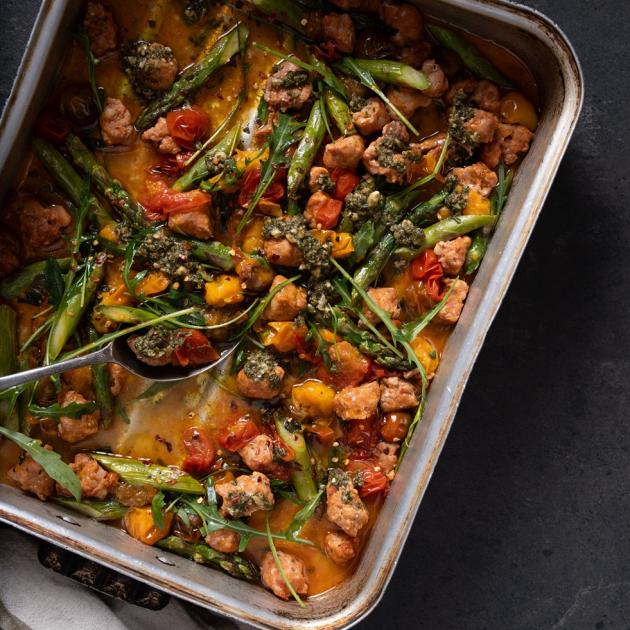 Roasted chorizo, cherry tomato and asparagus tray bake with pesto
Roasted chorizo, cherry tomato and asparagus tray bake with pesto

This quick and flavour-packed tray bake is perfect for summer weeknights: minimal prep for maximum flavour. Juicy cherry tomatoes, tender asparagus and spiced chorizo come together in just minutes, finished with fresh pesto and rocket. Serve with warm, crusty bread to mop up the tomato juices, or make it more substantial with pasta, couscous, roast potatoes or kumara.
Serves 3-4
Prep time 10min
Cook time 15-18min
Ingredients
250-300g raw chorizo sausages
2 punnets cherry tomatoes
1 bunch asparagus spears, trimmed and cut into 3cm lengths
1 sprig thyme, leaves only
1-2 Tbsp olive oil
2-3 Tbsp pesto (store-bought or garden herb and weed — see below)
2 large handfuls rocket
Method
Preheat oven to 220°C. Squeeze small blobs of chorizo directly from the sausage casing into a large roasting tray, spacing them out slightly. Add cherry tomatoes, asparagus and thyme leaves. Drizzle with olive oil and toss gently to combine.
Roast for 12-15 minutes, or until the chorizo is cooked through, the tomatoes are blistered and juicy and the asparagus is tender with some bite.
Remove tray from the oven and dot spoonfuls of pesto over the top. Return to the oven for 2-3 more minutes, just to warm the pesto through.
Take the tray out of the oven and immediately add the rocket, tossing gently until it’s just wilted from the residual heat. Serve hot, straight from the tray.

Garden herb and weed pesto
Pesto is one of the most versatile and flexible recipes — a fresh, vibrant, punchy blend of whatever herbs (and even edible weeds) you have on hand. It’s perfect for adding piquancy to any number of dishes. I’ve made pesto more than a hundred times, and I reckon no two batches have ever been the same — the combinations of herbs, greens and nuts are endless. Some of my favourite pairings include mint and pistachio, parsley and walnut or pine nuts, coriander and cashew with chickweed, rocket, sorrel, carrot tops, fathen or purslane thrown in. I make it in bulk when the herbs are abundant and freeze, so we have a stash that lasts all year. Once you start experimenting, you’ll never be without a jar in the fridge.
Makes 2 cups
Prep time 15min
Ingredients
4 cups fresh soft mixed herbs and/or weeds (suitable herbs and weeds below)
1 clove garlic, roughly chopped
juice of ½ lemon, to taste
¾ cup extra-virgin olive oil + more as needed
½ cup grated parmesan
¾ cup nuts or seeds (pine nuts, almonds, walnuts, sunflower seeds or a mix)
Suitable base herbs:
Parsley, basil, coriander, mint
Suitable secondary herbs:
Dill, tarragon, fennel fronds, sorrel, carrot tops
Suitable base weeds:
Chickweed — mild and slightly sweet, with a delicate texture.
Nettle — rich in nutrients, with a deep, green flavour. Blanch in boiling water to remove the sting before using.
Fathen — a mild-flavoured green similar to spinach.
Suitable secondary weeds:
Wild fennel fronds — feathery leaves with a sweet, aniseed flavour.
Nasturtium leaves — peppery and bold, like watercress. Use sparingly.
Purslane — succulent leaves with a lemony, peppery crunch.
Method
Rinse the herb and weed selection and dry well. Remove any tough stems, then roughly chop.
In a food processor or blender, combine the herbs (and weeds if using), garlic and lemon juice. Pulse until finely chopped.
Blend in the olive oil with the motor running until smooth. Add a little more oil if needed to loosen.
Pulse in the nuts and/or seeds and parmesan and pulse to your desired consistency. Add a good pinch of salt and pepper, then taste and adjust seasoning.
Store in a sealed jar in the fridge for up to a week, or freeze in half-cup portions in ziplock bags.











